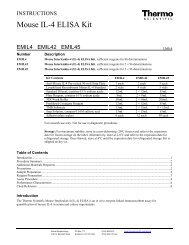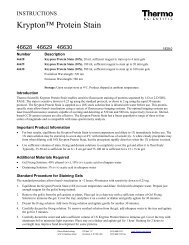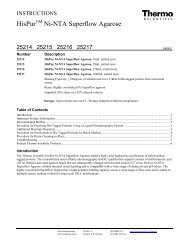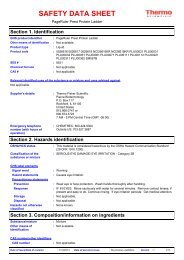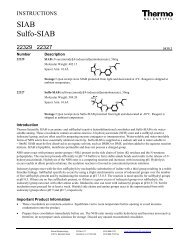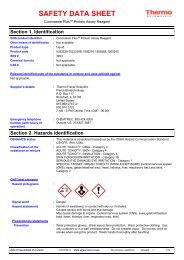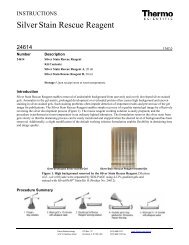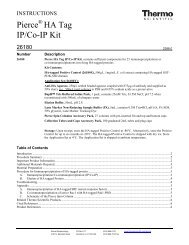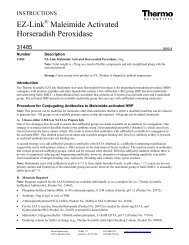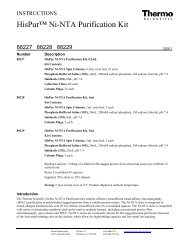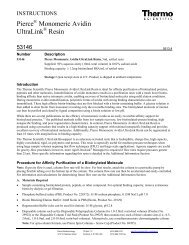MSDS# 8030 COVER SHEET - Pierce
MSDS# 8030 COVER SHEET - Pierce
MSDS# 8030 COVER SHEET - Pierce
You also want an ePaper? Increase the reach of your titles
YUMPU automatically turns print PDFs into web optimized ePapers that Google loves.
<strong>MSDS#</strong> <strong>8030</strong> <strong>COVER</strong> <strong>SHEET</strong><br />
53027 FITC Antibody Labeling Kit<br />
Component #<br />
Description<br />
1861423 FITC<br />
1860511 Antibody Labeling Kit<br />
Life Science Research PO Box 117 Rockford, IL (815) 968-0747 www.thermo.com<br />
<strong>Pierce</strong> Biotechnology Inc. 3747 N. Meridian Road 61105 (815) 968-7316 fax
<strong>MSDS#</strong> <strong>8030</strong> <strong>COVER</strong> <strong>SHEET</strong><br />
53027 FITC Antibody Labeling Kit<br />
Component #<br />
Description<br />
1861423 FITC<br />
1860511 Antibody Labeling Kit<br />
Life Science Research PO Box 117 Rockford, IL (815) 968-0747 www.thermo.com<br />
<strong>Pierce</strong> Biotechnology Inc. 3747 N. Meridian Road 61105 (815) 968-7316 fax
<strong>MSDS#</strong> <strong>8030</strong> <strong>COVER</strong> <strong>SHEET</strong><br />
53027 FITC Antibody Labeling Kit<br />
Component #<br />
Description<br />
1861423 FITC<br />
1860511 Antibody Labeling Kit<br />
Life Science Research PO Box 117 Rockford, IL (815) 968-0747 www.thermo.com<br />
<strong>Pierce</strong> Biotechnology Inc. 3747 N. Meridian Road 61105 (815) 968-7316 fax
<strong>MSDS#</strong> <strong>8030</strong> <strong>COVER</strong> <strong>SHEET</strong><br />
53027 FITC Antibody Labeling Kit<br />
Component #<br />
Description<br />
1861423 FITC<br />
1860511 Antibody Labeling Kit<br />
Life Science Research PO Box 117 Rockford, IL (815) 968-0747 www.thermo.com<br />
<strong>Pierce</strong> Biotechnology Inc. 3747 N. Meridian Road 61105 (815) 968-7316 fax
<strong>MSDS#</strong> <strong>8030</strong> <strong>COVER</strong> <strong>SHEET</strong><br />
53027 FITC Antibody Labeling Kit<br />
Component #<br />
Description<br />
1861423 FITC<br />
1860511 Antibody Labeling Kit<br />
Life Science Research PO Box 117 Rockford, IL (815) 968-0747 www.thermo.com<br />
<strong>Pierce</strong> Biotechnology Inc. 3747 N. Meridian Road 61105 (815) 968-7316 fax
MSDS #7543 <strong>COVER</strong> <strong>SHEET</strong><br />
1860511<br />
DyLight Antibody Labeling Kit<br />
Component B<br />
Component #<br />
Description<br />
1859833 Borate Buffer, 0.67M<br />
1860513 Purification Resin<br />
1860512<br />
DyLight Microscale Antibody<br />
Labeling Kit<br />
Component #<br />
Description<br />
1859833 Borate Buffer, 0.67M<br />
1860513 Purification Resin<br />
1862394<br />
DyLight Antibody Labeling Kit<br />
Component B<br />
Component #<br />
Description<br />
1859833 Borate Buffer, 0.67M<br />
1860513 Purification Resin<br />
1862395<br />
DyLight Microscale Antibody<br />
Labeling Kit Component B<br />
Component #<br />
Description<br />
1859833 Borate Buffer, 0.67M<br />
1860513 Purification Resin<br />
Life Science Research PO Box 117 Rockford, IL (815) 968-0747 www.thermo.com<br />
<strong>Pierce</strong> Biotechnology, Inc. 3747 N. Meridian Road 61105 (815) 968-7316 fax
Part of Thermo Fisher Scientific<br />
1 .<br />
Product name<br />
Supplier<br />
Product No.<br />
MSDS #<br />
Validation date<br />
Print date<br />
Responsible name<br />
In case of emergency<br />
2 .<br />
Material Safety Data Sheet<br />
Product and company identification<br />
: 0.67M Borate Buffer<br />
: Thermo Fisher Scientific<br />
<strong>Pierce</strong> Biotechnology<br />
P.O. Box 117<br />
Rockford, IL 61105<br />
United States<br />
815.968.0747 or<br />
800.874.3723<br />
:<br />
:<br />
:<br />
:<br />
:<br />
:<br />
1859833<br />
7325<br />
9/23/2009.<br />
9/23/2009.<br />
MSDS (Regulatory Affairs)<br />
CHEMTREC:<br />
800.424.9300<br />
OUTSIDE US:<br />
202.483.7616<br />
Hazards identification<br />
Physical state<br />
Odor<br />
OSHA/HCS status<br />
Irritating to eyes.<br />
Manufacturer<br />
Use of<br />
Substance/Preparation<br />
:<br />
: Thermo Fisher Scientific<br />
<strong>Pierce</strong> Biotechnology<br />
P.O. Box 117<br />
Rockford, IL 61105<br />
United States<br />
815.968.0747<br />
800.874.3723<br />
Refer to the instruction booklet for<br />
proper and intended use.<br />
Otherwise, contact supplier for<br />
specific applications.<br />
Emergency overview : WARNING !<br />
CAUSES RESPIRATORY TRACT, EYE AND SKIN IRRITATION. CONTAINS<br />
MATERIAL THAT CAN CAUSE TARGET ORGAN DAMAGE. POSSIBLE<br />
REPRODUCTIVE HAZARD - CONTAINS MATERIAL WHICH MAY CAUSE ADVERSE<br />
REPRODUCTIVE EFFECTS IN MALES, BASED ON ANIMAL DATA.<br />
Irritating to eyes, respiratory system and skin. Avoid exposure - obtain special<br />
instructions before use. Do not breathe vapor or mist. Avoid contact with eyes, skin and<br />
clothing. Contains material that can cause target organ damage. Contains material<br />
which may impair male fertility, based on animal data. Use only with adequate<br />
ventilation. Keep container tightly closed and sealed until ready for use. Wash<br />
thoroughly after handling.<br />
Routes of entry<br />
: Dermal contact. Eye contact. Inhalation. Ingestion.<br />
Potential acute health effects<br />
Inhalation<br />
: Irritating to respiratory system.<br />
Ingestion<br />
: No known significant effects or critical hazards.<br />
Irritating to skin.<br />
Skin<br />
Eyes<br />
: Liquid. [Clear sparkling liquid.]<br />
: Odorless.<br />
: This material is considered hazardous by the OSHA Hazard Communication Standard<br />
(29 CFR 1910.1200).<br />
:<br />
:<br />
Potential chronic health effects<br />
Chronic effects<br />
: Contains material that can cause target organ damage.<br />
9/23/2009.<br />
Biosciences Division 3747 N. Meridian Rd. Rockford, IL (815) 968-0747 www.thermo.com/pierce<br />
<strong>Pierce</strong> PO Box 117 61105 (815) 968-7316 Fax<br />
1/9<br />
0.67M Borate Buffer<br />
2 .<br />
Hazards identification<br />
Carcinogenicity<br />
Mutagenicity<br />
Teratogenicity<br />
Developmental effects<br />
Fertility effects<br />
Target organs<br />
Medical conditions<br />
aggravated by overexposure<br />
: No known significant effects or critical hazards.<br />
: No known significant effects or critical hazards.<br />
: No known significant effects or critical hazards.<br />
: No known significant effects or critical hazards.<br />
: Contains material which may impair male fertility, based on animal data.<br />
: Contains material which causes damage to the following organs: kidneys, the<br />
reproductive system, liver, upper respiratory tract, skin, central nervous system (CNS),<br />
eye, lens or cornea, testes.<br />
Over-exposure signs/symptoms<br />
Inhalation<br />
: Adverse symptoms may include the following:<br />
respiratory tract irritation<br />
coughing<br />
Ingestion<br />
Skin<br />
Eyes<br />
: No specific data.<br />
: Adverse symptoms may include the following:<br />
irritation<br />
redness<br />
: Adverse symptoms may include the following:<br />
pain or irritation<br />
watering<br />
redness<br />
: Pre-existing disorders involving any target organs mentioned in this MSDS as being at<br />
risk may be aggravated by over-exposure to this product.<br />
The preparation is classified as dangerous according to Directive 1999/45/EC and its amendments.<br />
Classification<br />
: Repr. Cat. 2; R60, R61<br />
Human health hazards : May impair fertility. May cause harm to the unborn child.<br />
See toxicological information (section 11)<br />
3 .<br />
Composition/information on ingredients<br />
United States<br />
Name CAS number %<br />
Boric Acid Sodium Salt 1303-96-4 7 - 10<br />
Boric Acid 10043-35-3 5 - 7<br />
Europe<br />
Substance/preparation : Preparation<br />
Ingredient name<br />
CAS % EC number Classification<br />
number<br />
Boric Acid Sodium Salt 1303-96-4 7 - 10 215-540-4 Repr. Cat. 2; [1] [2]<br />
R60, R61<br />
Boric Acid 10043-35-3 5 - 7 233-139-2 Repr. Cat. 2; [1] [2]<br />
R60, R61<br />
There are no ingredients or additional ingredients present which, within the current knowledge of the supplier and<br />
in the concentrations applicable, are classified as hazardous to health or the environment and hence require<br />
reporting in this section.<br />
[1] Substance classified with a health or environmental hazard<br />
9/23/2009.<br />
2/9<br />
Biosciences Division 3747 N. Meridian Rd. Rockford, IL (815) 968-0747 www.thermo.com/pierce<br />
<strong>Pierce</strong> PO Box 117 61105 (815) 968-7316 Fax
0.67M Borate Buffer<br />
3 .<br />
Composition/information on ingredients<br />
[2] Substance with a workplace exposure limit<br />
Occupational exposure limits, if available, are listed in section 8.<br />
4 .<br />
Inhalation<br />
Ingestion<br />
Skin contact<br />
First aid measures<br />
:<br />
:<br />
:<br />
Get medical attention immediately. Move exposed person to fresh air. If it is suspected<br />
that fumes are still present, the rescuer should wear an appropriate mask or selfcontained<br />
breathing apparatus. Keep person warm and at rest. If not breathing, if<br />
breathing is irregular or if respiratory arrest occurs, provide artificial respiration or oxygen<br />
by trained personnel. It may be dangerous to the person providing aid to give mouth-tomouth<br />
resuscitation. If unconscious, place in recovery position and get medical attention<br />
immediately. Maintain an open airway. Loosen tight clothing such as a collar, tie, belt or<br />
waistband.<br />
Get medical attention immediately. Wash out mouth with water. Remove dentures if<br />
any. Move exposed person to fresh air. Keep person warm and at rest. If material has<br />
been swallowed and the exposed person is conscious, give small quantities of water to<br />
drink. Stop if the exposed person feels sick as vomiting may be dangerous. Do not<br />
induce vomiting unless directed to do so by medical personnel. If vomiting occurs, the<br />
head should be kept low so that vomit does not enter the lungs. Never give anything by<br />
mouth to an unconscious person. If unconscious, place in recovery position and get<br />
medical attention immediately. Maintain an open airway. Loosen tight clothing such as<br />
a collar, tie, belt or waistband.<br />
Flush contaminated skin with plenty of water. Remove contaminated clothing and<br />
shoes. Wash contaminated clothing thoroughly with water before removing or wear<br />
gloves. Continue to rinse for at least 10 minutes. Get medical attention. Wash clothing<br />
before reuse. Clean shoes thoroughly before reuse.<br />
Eye contact<br />
: Immediately flush eyes with plenty of water for at least 15 minutes, occasionally lifting<br />
the upper and lower eyelids. Check for and remove any contact lenses. Get medical<br />
attention.<br />
Protection of first-aiders : No action shall be taken involving any personal risk or without suitable training. If it is<br />
suspected that fumes are still present, the rescuer should wear an appropriate mask or<br />
self-contained breathing apparatus. It may be dangerous to the person providing aid to<br />
give mouth-to-mouth resuscitation. Wash contaminated clothing thoroughly with water<br />
before removing or wear gloves.<br />
See section 11 for more detailed information on health effects and symptoms.<br />
5 .<br />
Fire-fighting measures<br />
Flammability of the product : In a fire or if heated, a pressure increase will occur and the container may burst.<br />
Extinguishing media<br />
Suitable : Use an extinguishing agent suitable for the surrounding fire.<br />
Not suitable : None known.<br />
Special exposure hazards : Promptly isolate the scene by removing all persons from the vicinity of the incident if<br />
there is a fire. No action shall be taken involving any personal risk or without suitable<br />
training.<br />
Hazardous combustion<br />
products<br />
Special protective<br />
equipment for fire-fighters<br />
: Decomposition products may include the following materials:<br />
metal oxide/oxides<br />
: Fire-fighters should wear appropriate protective equipment and self-contained breathing<br />
apparatus (SCBA) with a full face-piece operated in positive pressure mode.<br />
0.67M Borate Buffer<br />
6 .<br />
Accidental release measures<br />
Personal precautions :<br />
Environmental precautions<br />
Large spill :<br />
No action shall be taken involving any personal risk or without suitable training.<br />
Evacuate surrounding areas. Keep unnecessary and unprotected personnel from<br />
entering. Do not touch or walk through spilled material. Avoid breathing vapor or mist.<br />
Provide adequate ventilation. Wear appropriate respirator when ventilation is<br />
inadequate. Put on appropriate personal protective equipment (see section 8).<br />
: Avoid dispersal of spilled material and runoff and contact with soil, waterways, drains<br />
and sewers. Inform the relevant authorities if the product has caused environmental<br />
pollution (sewers, waterways, soil or air).<br />
Stop leak if without risk. Move containers from spill area. Approach release from<br />
upwind. Prevent entry into sewers, water courses, basements or confined areas. Wash<br />
spillages into an effluent treatment plant or proceed as follows. Contain and collect<br />
spillage with non-combustible, absorbent material e.g. sand, earth, vermiculite or<br />
diatomaceous earth and place in container for disposal according to local regulations<br />
(see section 13). Dispose of via a licensed waste disposal contractor. Contaminated<br />
absorbent material may pose the same hazard as the spilled product. Note: see section<br />
1 for emergency contact information and section 13 for waste disposal.<br />
Small spill : Stop leak if without risk. Move containers from spill area. Dilute with water and mop up<br />
if water-soluble or absorb with an inert dry material and place in an appropriate waste<br />
disposal container. Dispose of via a licensed waste disposal contractor.<br />
7 .<br />
Handling<br />
Storage<br />
8 .<br />
Product name<br />
Handling and storage<br />
United States<br />
borates, tetra, sodium salts- decahydrate<br />
:<br />
:<br />
Put on appropriate personal protective equipment (see section 8). Eating, drinking and<br />
smoking should be prohibited in areas where this material is handled, stored and<br />
processed. Workers should wash hands and face before eating, drinking and smoking.<br />
Do not get in eyes or on skin or clothing. Do not breathe vapor or mist. Do not ingest.<br />
Use only with adequate ventilation. Wear appropriate respirator when ventilation is<br />
inadequate. Keep in the original container or an approved alternative made from a<br />
compatible material, kept tightly closed when not in use. Empty containers retain<br />
product residue and can be hazardous. Do not reuse container.<br />
Store between the following temperatures: 2 to 8°C (35.6 to 46.4°F). Store in<br />
accordance with local regulations. Store in original container protected from direct<br />
sunlight in a dry, cool and well-ventilated area, away from incompatible materials (see<br />
section 10) and food and drink. Keep container tightly closed and sealed until ready for<br />
use. Containers that have been opened must be carefully resealed and kept upright to<br />
prevent leakage. Do not store in unlabeled containers. Use appropriate containment to<br />
avoid environmental contamination.<br />
Exposure controls/personal protection<br />
Exposure limits<br />
ACGIH (United States).<br />
STEL: 6 mg/m³<br />
ACGIH TLV (United States).<br />
TWA: 2 mg/m³<br />
OSHA (United States, 0/1989).<br />
TWA: 10 mg/m³<br />
ACGIH TLV (United States, 1/2008).<br />
STEL: 6 mg/m³ 15 minute(s).<br />
TWA: 2 mg/m³ 8 hour(s).<br />
NIOSH REL (United States, 6/2008).<br />
9/23/2009.<br />
3/9<br />
9/23/2009.<br />
4/9<br />
Biosciences Division 3747 N. Meridian Rd. Rockford, IL (815) 968-0747 www.thermo.com/pierce<br />
<strong>Pierce</strong> PO Box 117 61105 (815) 968-7316 Fax<br />
Biosciences Division 3747 N. Meridian Rd. Rockford, IL (815) 968-0747 www.thermo.com/pierce<br />
<strong>Pierce</strong> PO Box 117 61105 (815) 968-7316 Fax
0.67M Borate Buffer<br />
8 .<br />
boric acid<br />
Exposure controls/personal protection<br />
Europe<br />
borates, tetra, sodium salts- decahydrate<br />
boric acid<br />
Consult local authorities for acceptable exposure limits.<br />
Recommended monitoring<br />
procedures<br />
Engineering measures<br />
Hygiene measures<br />
Personal protection<br />
Respiratory<br />
Eyes<br />
Skin<br />
:<br />
:<br />
:<br />
TWA: 5 mg/m³ 10 hour(s).<br />
OSHA PEL 1989 (United States, 3/1989).<br />
TWA: 10 mg/m³ 8 hour(s).<br />
ACGIH TLV (United States).<br />
STEL: 6 mg/m³<br />
TWA: 2 mg/m³<br />
STEL: 6 mg/m³ 15 minute(s).<br />
TWA: 2 mg/m³ 8 hour(s).<br />
ACGIH (United States).<br />
STEL: 6 mg/m³<br />
ACGIH TLV (United States).<br />
TWA: 2 mg/m³<br />
STEL: 6 mg/m³ 15 minute(s).<br />
TWA: 2 mg/m³ 8 hour(s).<br />
ACGIH TLV (United States).<br />
STEL: 6 mg/m³<br />
TWA: 2 mg/m³<br />
STEL: 6 mg/m³ 15 minute(s).<br />
TWA: 2 mg/m³ 8 hour(s).<br />
: If this product contains ingredients with exposure limits, personal, workplace atmosphere<br />
or biological monitoring may be required to determine the effectiveness of the ventilation<br />
or other control measures and/or the necessity to use respiratory protective equipment.<br />
: Use only with adequate ventilation. If user operations generate dust, fumes, gas, vapor<br />
or mist, use process enclosures, local exhaust ventilation or other engineering controls<br />
to keep worker exposure to airborne contaminants below any recommended or statutory<br />
limits.<br />
: Wash hands, forearms and face thoroughly after handling chemical products, before<br />
eating, smoking and using the lavatory and at the end of the working period. Appropriate<br />
techniques should be used to remove potentially contaminated clothing. Wash<br />
contaminated clothing before reusing. Ensure that eyewash stations and safety showers<br />
are close to the workstation location.<br />
Use a properly fitted, air-purifying or air-fed respirator complying with an approved<br />
standard if a risk assessment indicates this is necessary. Respirator selection must be<br />
based on known or anticipated exposure levels, the hazards of the product and the safe<br />
working limits of the selected respirator.<br />
Hands : Chemical-resistant, impervious gloves complying with an approved standard should be<br />
worn at all times when handling chemical products if a risk assessment indicates this is<br />
necessary.<br />
Safety eyewear complying with an approved standard should be used when a risk<br />
assessment indicates this is necessary to avoid exposure to liquid splashes, mists,<br />
gases or dusts.<br />
Personal protective equipment for the body should be selected based on the task being<br />
performed and the risks involved and should be approved by a specialist before handling<br />
this product.<br />
0.67M Borate Buffer<br />
8 .<br />
Exposure controls/personal protection<br />
Environmental exposure<br />
controls<br />
9 .<br />
Physical state<br />
Color<br />
Odor<br />
pH<br />
Solubility<br />
10 .<br />
: Emissions from ventilation or work process equipment should be checked to ensure they<br />
comply with the requirements of environmental protection legislation. In some cases,<br />
fume scrubbers, filters or engineering modifications to the process equipment will be<br />
necessary to reduce emissions to acceptable levels.<br />
Physical and chemical properties<br />
: Liquid. [Clear sparkling liquid.]<br />
: Colorless.<br />
: Odorless.<br />
:<br />
:<br />
Stability and reactivity<br />
Chemical stability<br />
Conditions to avoid<br />
Incompatible materials<br />
Hazardous decomposition<br />
products<br />
Possibility of hazardous<br />
reactions<br />
11 .<br />
:<br />
7 to 9<br />
Easily soluble in the following materials: cold water and hot water.<br />
The product is stable. Under normal conditions of storage and use, hazardous<br />
polymerization will not occur.<br />
Avoid exposure - obtain special instructions before use.<br />
:<br />
: No specific data.<br />
:<br />
Under normal conditions of storage and use, hazardous decomposition products should<br />
not be produced.<br />
: Will not occur.<br />
Toxicological information<br />
United States<br />
Acute toxicity<br />
Product/ingredient name Result Species Dose Exposure<br />
borates, tetra, sodium salts- decahydrate LD50 Oral Rat 2660 mg/kg -<br />
boric acid LD50 Dermal Rabbit >2000 mg/kg -<br />
LD50 Oral Rat 2660 mg/kg -<br />
LC50 Inhalation Rat >0.16 mg/L 4 hours<br />
Gas.<br />
Conclusion/Summary : Not available.<br />
Chronic toxicity<br />
Conclusion/Summary : Not available.<br />
Carcinogenicity<br />
Conclusion/Summary : Not available.<br />
Classification<br />
Product/ingredient name ACGIH IARC EPA NIOSH NTP OSHA<br />
borates, tetra, sodium salts- decahydrate A4 - - + - -<br />
boric acid A4 - - None. - None.<br />
Mutagenicity<br />
Conclusion/Summary : Not available.<br />
Teratogenicity<br />
Conclusion/Summary : Not available.<br />
9/23/2009.<br />
5/9<br />
9/23/2009.<br />
6/9<br />
Biosciences Division 3747 N. Meridian Rd. Rockford, IL (815) 968-0747 www.thermo.com/pierce<br />
<strong>Pierce</strong> PO Box 117 61105 (815) 968-7316 Fax<br />
Biosciences Division 3747 N. Meridian Rd. Rockford, IL (815) 968-0747 www.thermo.com/pierce<br />
<strong>Pierce</strong> PO Box 117 61105 (815) 968-7316 Fax
0.67M Borate Buffer<br />
11 .<br />
Europe<br />
Toxicological information<br />
Reproductive toxicity<br />
Conclusion/Summary : Not available.<br />
Chronic effects : No known significant effects or critical hazards.<br />
Carcinogenicity : No known significant effects or critical hazards.<br />
Mutagenicity<br />
: No known significant effects or critical hazards.<br />
Teratogenicity<br />
: May cause birth defects.<br />
Developmental effects : No known significant effects or critical hazards.<br />
Fertility effects<br />
: May impair fertility.<br />
12 .<br />
Ecological information<br />
Environmental effects<br />
United States<br />
Aquatic ecotoxicity<br />
Conclusion/Summary<br />
Other adverse effects<br />
13 .<br />
Disposal considerations<br />
Waste disposal<br />
Hazardous waste<br />
: No known significant effects or critical hazards.<br />
: Not available.<br />
: No known significant effects or critical hazards.<br />
:<br />
The generation of waste should be avoided or minimized wherever possible. Dispose of<br />
surplus and non-recyclable products via a licensed waste disposal contractor. Disposal<br />
of this product, solutions and any by-products should at all times comply with the<br />
requirements of environmental protection and waste disposal legislation and any regional<br />
local authority requirements. Avoid dispersal of spilled material and runoff and contact<br />
with soil, waterways, drains and sewers.<br />
: The classification of the product may meet the criteria for a hazardous waste.<br />
Disposal should be in accordance with applicable regional, national and local laws and regulations.<br />
Refer to Section 7: HANDLING AND STORAGE and Section 8: EXPOSURE CONTROLS/PERSONAL PROTECTION<br />
for additional handling information and protection of employees.<br />
14 .<br />
Regulatory<br />
information<br />
Transport information<br />
UN number<br />
Proper shipping<br />
name<br />
Classes<br />
DOT Classification Not<br />
- -<br />
-<br />
regulated.<br />
IATA-DGR Class Not available. Not available. Not available. -<br />
PG* : Packing group<br />
PG*<br />
0.67M Borate Buffer<br />
15 .<br />
United States<br />
Regulatory information<br />
HCS Classification<br />
U.S. Federal regulations<br />
Canada<br />
WHMIS (Canada)<br />
Canadian lists :<br />
Canada inventory<br />
EU regulations<br />
Hazard symbol or symbols<br />
Risk phrases<br />
Safety phrases<br />
International regulations<br />
International lists<br />
Irritating material<br />
Target organ effects<br />
: United States inventory (TSCA 8b): All components are listed or exempted.<br />
SARA 302/304/311/312 extremely hazardous substances: No products were found.<br />
SARA 302/304 emergency planning and notification: No products were found.<br />
SARA 302/304/311/312 hazardous chemicals: boric acid; borates, tetra, sodium saltsdecahydrate<br />
SARA 311/312 MSDS distribution - chemical inventory - hazard identification: boric<br />
acid: Immediate (acute) health hazard, Delayed (chronic) health hazard; borates, tetra,<br />
sodium salts- decahydrate: Delayed (chronic) health hazard<br />
:<br />
:<br />
:<br />
Clean Water Act (CWA) 307: No products were found.<br />
Clean Water Act (CWA) 311: No products were found.<br />
Clean Air Act (CAA) 112 accidental release prevention: No products were found.<br />
Clean Air Act (CAA) 112 regulated flammable substances: No products were found.<br />
Clean Air Act (CAA) 112 regulated toxic substances: No products were found.<br />
Class D-2A: Material causing other toxic effects (Very toxic).<br />
Class D-2B: Material causing other toxic effects (Toxic).<br />
CEPA Toxic substances: None of the components are listed.<br />
Canadian ARET: None of the components are listed.<br />
Canadian NPRI: None of the components are listed.<br />
Alberta Designated Substances: None of the components are listed.<br />
Ontario Designated Substances: None of the components are listed.<br />
Quebec Designated Substances: None of the components are listed.<br />
: Canada inventory: All components are listed or exempted.<br />
:<br />
Toxic<br />
: R60- May impair fertility.<br />
R61- May cause harm to the unborn child.<br />
: S53- Avoid exposure - obtain special instructions before use.<br />
Australia inventory (AICS): All components are listed or exempted.<br />
China inventory (IECSC): All components are listed or exempted.<br />
Korea inventory (KECI): All components are listed or exempted.<br />
Philippines inventory (PICCS): All components are listed or exempted.<br />
Japan inventory (ENCS): All components are listed or exempted.<br />
9/23/2009.<br />
7/9<br />
9/23/2009.<br />
8/9<br />
Biosciences Division 3747 N. Meridian Rd. Rockford, IL (815) 968-0747 www.thermo.com/pierce<br />
<strong>Pierce</strong> PO Box 117 61105 (815) 968-7316 Fax<br />
Biosciences Division 3747 N. Meridian Rd. Rockford, IL (815) 968-0747 www.thermo.com/pierce<br />
<strong>Pierce</strong> PO Box 117 61105 (815) 968-7316 Fax
0.67M Borate Buffer<br />
16 .<br />
Other information<br />
Label requirements : CAUSES RESPIRATORY TRACT, EYE AND SKIN IRRITATION. CONTAINS<br />
MATERIAL THAT CAN CAUSE TARGET ORGAN DAMAGE. POSSIBLE<br />
REPRODUCTIVE HAZARD - CONTAINS MATERIAL WHICH MAY CAUSE ADVERSE<br />
REPRODUCTIVE EFFECTS IN MALES, BASED ON ANIMAL DATA.<br />
Hazardous Material<br />
Information System (U.S.A.)<br />
:<br />
Health<br />
Flammability<br />
Physical hazards<br />
2<br />
0<br />
0<br />
The customer is responsible for determining the PPE code for this material.<br />
National Fire Protection :<br />
Association (U.S.A.)<br />
0 Flammability<br />
Health 2 0 Instability<br />
Special<br />
Date of printing<br />
Date of issue<br />
Date of previous issue<br />
Version<br />
Notice to reader<br />
: 9/23/2009.<br />
: 9/23/2009.<br />
: 5/28/2008.<br />
: 1.02<br />
Indicates information that has changed from previously issued version.<br />
Full text of R-phrases<br />
referred to in sections 2 and<br />
3 - Europe<br />
Full text of classifications<br />
referred to in sections 2 and<br />
3 - Europe<br />
: R60- May impair fertility.<br />
R61- May cause harm to the unborn child.<br />
: Repr. Cat. 2 - Toxic to reproduction Category 2<br />
To the best of our knowledge, the information contained herein is accurate. However, neither the above-named<br />
supplier, nor any of its subsidiaries, assumes any liability whatsoever for the accuracy or completeness of the<br />
information contained herein.<br />
Final determination of suitability of any material is the sole responsibility of the user. All materials may present<br />
unknown hazards and should be used with caution. Although certain hazards are described herein, we cannot<br />
guarantee that these are the only hazards that exist.<br />
This product has been classified according to the hazard criteria of the CPR and the MSDS contains all the information required by the CPR.<br />
9/23/2009.<br />
Biosciences Division 3747 N. Meridian Rd. Rockford, IL (815) 968-0747 www.thermo.com/pierce<br />
<strong>Pierce</strong> PO Box 117 61105 (815) 968-7316 Fax<br />
9/9
Part of Thermo Fisher Scientific<br />
1 .<br />
Product name<br />
Supplier<br />
Product No.<br />
MSDS #<br />
Validation date<br />
Print date<br />
Responsible name<br />
In case of emergency<br />
2 .<br />
Material Safety Data Sheet<br />
Product and company identification<br />
: Purification Resin<br />
: Thermo Fisher Scientific<br />
<strong>Pierce</strong> Biotechnology<br />
P.O. Box 117<br />
Rockford, IL 61105<br />
United States<br />
815.968.0747 or<br />
800.874.3723<br />
:<br />
:<br />
:<br />
:<br />
:<br />
:<br />
0022858 1860513 1901610<br />
7542<br />
7/29/2009.<br />
7/29/2009.<br />
MSDS (Regulatory Affairs)<br />
CHEMTREC:<br />
800.424.9300<br />
OUTSIDE US:<br />
202.483.7616<br />
Hazards identification<br />
Manufacturer<br />
Use of<br />
Substance/Preparation<br />
: Thermo Fisher Scientific<br />
<strong>Pierce</strong> Biotechnology<br />
P.O. Box 117<br />
Rockford, IL 61105<br />
United States<br />
815.968.0747<br />
800.874.3723<br />
Refer to the instruction booklet for<br />
proper and intended use.<br />
Otherwise, contact supplier for<br />
specific applications.<br />
Physical state<br />
: Liquid. [Resin in aqueous buffer]<br />
OSHA/HCS status<br />
: This material is considered hazardous by the OSHA Hazard Communication Standard<br />
(29 CFR 1910.1200).<br />
Emergency overview : WARNING !<br />
CAUSES RESPIRATORY TRACT, EYE AND SKIN IRRITATION. CONTAINS<br />
MATERIAL THAT CAN CAUSE TARGET ORGAN DAMAGE.<br />
Irritating to eyes, respiratory system and skin. Avoid exposure - obtain special<br />
instructions before use. Do not breathe vapor or mist. Avoid contact with eyes, skin and<br />
clothing. Contains material that can cause target organ damage. Use only with<br />
adequate ventilation. Keep container tightly closed and sealed until ready for use. Wash<br />
thoroughly after handling.<br />
Routes of entry<br />
: Dermal contact. Eye contact. Inhalation. Ingestion.<br />
Potential acute health effects<br />
Inhalation<br />
: Irritating to respiratory system. Exposure to decomposition products may cause a health<br />
hazard. Serious effects may be delayed following exposure.<br />
Ingestion<br />
: No known significant effects or critical hazards.<br />
Skin<br />
: Irritating to skin.<br />
Eyes<br />
: Irritating to eyes.<br />
Potential chronic health effects<br />
Chronic effects<br />
: Contains material that can cause target organ damage.<br />
Carcinogenicity<br />
: No known significant effects or critical hazards.<br />
Mutagenicity<br />
: No known significant effects or critical hazards.<br />
Purification Resin<br />
2 .<br />
Hazards identification<br />
Teratogenicity<br />
Developmental effects<br />
Fertility effects<br />
Target organs<br />
Medical conditions<br />
aggravated by overexposure<br />
: No known significant effects or critical hazards.<br />
: No known significant effects or critical hazards.<br />
: No known significant effects or critical hazards.<br />
: Contains material which causes damage to the following organs: mucous membranes,<br />
skin.<br />
Contains material which may cause damage to the following organs: lungs, upper<br />
respiratory tract, eye, lens or cornea, stomach, throat.<br />
Over-exposure signs/symptoms<br />
Inhalation<br />
: Adverse symptoms may include the following:<br />
respiratory tract irritation<br />
coughing<br />
Ingestion<br />
Skin<br />
Eyes<br />
: No specific data.<br />
: Adverse symptoms may include the following:<br />
irritation<br />
redness<br />
: Adverse symptoms may include the following:<br />
pain or irritation<br />
watering<br />
redness<br />
: Pre-existing disorders involving any target organs mentioned in this MSDS as being at<br />
risk may be aggravated by over-exposure to this product.<br />
The preparation is not classified as dangerous according to Directive 1999/45/EC and its amendments.<br />
Classification<br />
: Not classified.<br />
See toxicological information (section 11)<br />
3 .<br />
United States<br />
Composition/information on ingredients<br />
Name CAS number %<br />
Sodium Phosphate, Dibasic 7558-79-4 1 - 3<br />
Sodium Chloride 7647-14-5 1 - 3<br />
Europe<br />
Substance/preparation<br />
Ingredient name<br />
: Preparation<br />
CAS<br />
number<br />
% EC number Classification<br />
Sodium Phosphate, Dibasic 7558-79-4 1 - 3 231-448-7 Xi;<br />
[1]<br />
R36/37/38<br />
There are no ingredients or additional ingredients present which, within the current knowledge of the supplier and<br />
in the concentrations applicable, are classified as hazardous to health or the environment and hence require<br />
reporting in this section.<br />
[1] Substance classified with a health or environmental hazard<br />
[2] Substance with a workplace exposure limit<br />
Occupational exposure limits, if available, are listed in section 8.<br />
7/29/2009.<br />
1/9<br />
7/29/2009.<br />
2/9<br />
Biosciences Division 3747 N. Meridian Rd. Rockford, IL (815) 968-0747 www.thermo.com/pierce<br />
<strong>Pierce</strong> PO Box 117 61105 (815) 968-7316 Fax<br />
Biosciences Division 3747 N. Meridian Rd. Rockford, IL (815) 968-0747 www.thermo.com/pierce<br />
<strong>Pierce</strong> PO Box 117 61105 (815) 968-7316 Fax
Purification Resin<br />
4 .<br />
Inhalation<br />
Ingestion<br />
First aid measures<br />
:<br />
:<br />
Move exposed person to fresh air. If it is suspected that fumes are still present, the<br />
rescuer should wear an appropriate mask or self-contained breathing apparatus. Keep<br />
person warm and at rest. If not breathing, if breathing is irregular or if respiratory arrest<br />
occurs, provide artificial respiration or oxygen by trained personnel. It may be dangerous<br />
to the person providing aid to give mouth-to-mouth resuscitation. Get medical attention.<br />
If unconscious, place in recovery position and get medical attention immediately.<br />
Maintain an open airway. Loosen tight clothing such as a collar, tie, belt or waistband.<br />
In case of inhalation of decomposition products in a fire, symptoms may be delayed.<br />
The exposed person may need to be kept under medical surveillance for 48 hours.<br />
Wash out mouth with water. Remove dentures if any. Move exposed person to fresh<br />
air. Keep person warm and at rest. If material has been swallowed and the exposed<br />
person is conscious, give small quantities of water to drink. Stop if the exposed person<br />
feels sick as vomiting may be dangerous. Do not induce vomiting unless directed to do<br />
so by medical personnel. If vomiting occurs, the head should be kept low so that vomit<br />
does not enter the lungs. Get medical attention. Never give anything by mouth to an<br />
unconscious person. If unconscious, place in recovery position and get medical<br />
attention immediately. Maintain an open airway. Loosen tight clothing such as a collar,<br />
tie, belt or waistband.<br />
Skin contact<br />
: Flush contaminated skin with plenty of water. Remove contaminated clothing and<br />
shoes. Continue to rinse for at least 10 minutes. Get medical attention. Wash clothing<br />
before reuse. Clean shoes thoroughly before reuse.<br />
Eye contact<br />
: Immediately flush eyes with plenty of water for at least 15 minutes, occasionally lifting<br />
the upper and lower eyelids. Check for and remove any contact lenses. Get medical<br />
attention.<br />
Protection of first-aiders : No action shall be taken involving any personal risk or without suitable training. If it is<br />
suspected that fumes are still present, the rescuer should wear an appropriate mask or<br />
self-contained breathing apparatus. It may be dangerous to the person providing aid to<br />
give mouth-to-mouth resuscitation.<br />
See section 11 for more detailed information on health effects and symptoms.<br />
5 .<br />
Fire-fighting measures<br />
Flammability of the product : In a fire or if heated, a pressure increase will occur and the container may burst.<br />
Extinguishing media<br />
Suitable : Use an extinguishing agent suitable for the surrounding fire.<br />
Not suitable : None known.<br />
Special exposure hazards : Promptly isolate the scene by removing all persons from the vicinity of the incident if<br />
there is a fire. No action shall be taken involving any personal risk or without suitable<br />
training.<br />
Hazardous combustion<br />
products<br />
Special protective<br />
equipment for fire-fighters<br />
: Decomposition products may include the following materials:<br />
carbon oxides<br />
nitrogen oxides<br />
phosphorus oxides<br />
halogenated compounds<br />
metal oxide/oxides<br />
: Fire-fighters should wear appropriate protective equipment and self-contained breathing<br />
apparatus (SCBA) with a full face-piece operated in positive pressure mode.<br />
Purification Resin<br />
6 .<br />
Accidental release measures<br />
Personal precautions :<br />
Environmental precautions<br />
Large spill :<br />
No action shall be taken involving any personal risk or without suitable training.<br />
Evacuate surrounding areas. Keep unnecessary and unprotected personnel from<br />
entering. Do not touch or walk through spilled material. Avoid breathing vapor or mist.<br />
Provide adequate ventilation. Wear appropriate respirator when ventilation is<br />
inadequate. Put on appropriate personal protective equipment (see section 8).<br />
: Avoid dispersal of spilled material and runoff and contact with soil, waterways, drains<br />
and sewers. Inform the relevant authorities if the product has caused environmental<br />
pollution (sewers, waterways, soil or air).<br />
Stop leak if without risk. Move containers from spill area. Approach release from<br />
upwind. Prevent entry into sewers, water courses, basements or confined areas. Wash<br />
spillages into an effluent treatment plant or proceed as follows. Contain and collect<br />
spillage with non-combustible, absorbent material e.g. sand, earth, vermiculite or<br />
diatomaceous earth and place in container for disposal according to local regulations<br />
(see section 13). Dispose of via a licensed waste disposal contractor. Contaminated<br />
absorbent material may pose the same hazard as the spilled product. Note: see section<br />
1 for emergency contact information and section 13 for waste disposal.<br />
Small spill : Stop leak if without risk. Move containers from spill area. Dilute with water and mop up<br />
if water-soluble or absorb with an inert dry material and place in an appropriate waste<br />
disposal container. Dispose of via a licensed waste disposal contractor.<br />
7 .<br />
Handling<br />
Storage<br />
8 .<br />
Handling and storage<br />
:<br />
:<br />
Put on appropriate personal protective equipment (see section 8). Eating, drinking and<br />
smoking should be prohibited in areas where this material is handled, stored and<br />
processed. Workers should wash hands and face before eating, drinking and smoking.<br />
Do not get in eyes or on skin or clothing. Do not breathe vapor or mist. Do not ingest.<br />
Use only with adequate ventilation. Wear appropriate respirator when ventilation is<br />
inadequate. Keep in the original container or an approved alternative made from a<br />
compatible material, kept tightly closed when not in use. Empty containers retain<br />
product residue and can be hazardous. Do not reuse container.<br />
Store between the following temperatures: 2 to 8°C (35.6 to 46.4°F). Store in<br />
accordance with local regulations. Store in original container protected from direct<br />
sunlight in a dry, cool and well-ventilated area, away from incompatible materials (see<br />
section 10) and food and drink. Keep container tightly closed and sealed until ready for<br />
use. Containers that have been opened must be carefully resealed and kept upright to<br />
prevent leakage. Do not store in unlabeled containers. Use appropriate containment to<br />
avoid environmental contamination.<br />
Exposure controls/personal protection<br />
Europe<br />
No exposure limit value known.<br />
Consult local authorities for acceptable exposure limits.<br />
Recommended monitoring<br />
procedures<br />
Engineering measures<br />
: If this product contains ingredients with exposure limits, personal, workplace atmosphere<br />
or biological monitoring may be required to determine the effectiveness of the ventilation<br />
or other control measures and/or the necessity to use respiratory protective equipment.<br />
: Use only with adequate ventilation. If user operations generate dust, fumes, gas, vapor<br />
or mist, use process enclosures, local exhaust ventilation or other engineering controls<br />
to keep worker exposure to airborne contaminants below any recommended or statutory<br />
limits.<br />
7/29/2009.<br />
3/9<br />
7/29/2009.<br />
4/9<br />
Biosciences Division 3747 N. Meridian Rd. Rockford, IL (815) 968-0747 www.thermo.com/pierce<br />
<strong>Pierce</strong> PO Box 117 61105 (815) 968-7316 Fax<br />
Biosciences Division 3747 N. Meridian Rd. Rockford, IL (815) 968-0747 www.thermo.com/pierce<br />
<strong>Pierce</strong> PO Box 117 61105 (815) 968-7316 Fax
Purification Resin<br />
8 .<br />
Exposure controls/personal protection<br />
Hygiene measures<br />
Personal protection<br />
Respiratory<br />
Eyes<br />
Skin<br />
: Wash hands, forearms and face thoroughly after handling chemical products, before<br />
eating, smoking and using the lavatory and at the end of the working period. Appropriate<br />
techniques should be used to remove potentially contaminated clothing. Wash<br />
contaminated clothing before reusing. Ensure that eyewash stations and safety showers<br />
are close to the workstation location.<br />
:<br />
:<br />
:<br />
Use a properly fitted, air-purifying or air-fed respirator complying with an approved<br />
standard if a risk assessment indicates this is necessary. Respirator selection must be<br />
based on known or anticipated exposure levels, the hazards of the product and the safe<br />
working limits of the selected respirator.<br />
Hands : Chemical-resistant, impervious gloves complying with an approved standard should be<br />
worn at all times when handling chemical products if a risk assessment indicates this is<br />
necessary.<br />
Environmental exposure<br />
controls<br />
9 .<br />
Safety eyewear complying with an approved standard should be used when a risk<br />
assessment indicates this is necessary to avoid exposure to liquid splashes, mists,<br />
gases or dusts.<br />
Personal protective equipment for the body should be selected based on the task being<br />
performed and the risks involved and should be approved by a specialist before handling<br />
this product.<br />
: Emissions from ventilation or work process equipment should be checked to ensure they<br />
comply with the requirements of environmental protection legislation. In some cases,<br />
fume scrubbers, filters or engineering modifications to the process equipment will be<br />
necessary to reduce emissions to acceptable levels.<br />
Physical and chemical properties<br />
Physical state<br />
Dispersibility properties<br />
10 .<br />
Stability and reactivity<br />
Chemical stability<br />
Conditions to avoid<br />
Incompatible materials<br />
Hazardous decomposition<br />
products<br />
Possibility of hazardous<br />
reactions<br />
11 .<br />
Toxicological information<br />
: Liquid. [Resin in aqueous buffer]<br />
: Easily dispersible in the following materials: cold water and hot water.<br />
: The product is stable. Under normal conditions of storage and use, hazardous<br />
polymerization will not occur.<br />
: No specific data.<br />
: No specific data.<br />
: Under normal conditions of storage and use, hazardous decomposition products should<br />
not be produced.<br />
: Will not occur.<br />
United States<br />
Acute toxicity<br />
Product/ingredient name Result Species Dose Exposure<br />
Purification Resin<br />
11 .<br />
Toxicological information<br />
sodium chloride LD50 Dermal Rabbit 10000 mg/kg -<br />
LD50<br />
Rat 2600 mg/kg -<br />
Intraperitoneal<br />
LD50 Oral Rat 3000 mg/kg -<br />
LDLo<br />
Rat 3.72 g/kg -<br />
Intraperitoneal<br />
LDLo<br />
Rat 3500 mg/kg -<br />
Subcutaneous<br />
LC50 Inhalation Rat >42 gm/m3 1 hours<br />
Dusts and mists<br />
sodium phosphate, dibasic LD50 Oral Rat 17000 mg/kg -<br />
LDLo<br />
Rat 1 g/kg -<br />
Intraperitoneal<br />
LDLo<br />
Rat 1 g/kg -<br />
Intramuscular<br />
LDLo<br />
Rat 1 g/kg -<br />
Subcutaneous<br />
Conclusion/Summary : Not available.<br />
Chronic toxicity<br />
Conclusion/Summary : Not available.<br />
Carcinogenicity<br />
Conclusion/Summary : Not available.<br />
Classification<br />
Product/ingredient name ACGIH IARC EPA NIOSH NTP OSHA<br />
sodium phosphate, dibasic - - - None. - None.<br />
sodium chloride - - - None. - None.<br />
Mutagenicity<br />
Conclusion/Summary : Not available.<br />
Teratogenicity<br />
Conclusion/Summary : Not available.<br />
Reproductive toxicity<br />
Conclusion/Summary : Not available.<br />
Europe<br />
Chronic effects : No known significant effects or critical hazards.<br />
Carcinogenicity : No known significant effects or critical hazards.<br />
Mutagenicity<br />
: No known significant effects or critical hazards.<br />
Teratogenicity<br />
: No known significant effects or critical hazards.<br />
Developmental effects : No known significant effects or critical hazards.<br />
Fertility effects<br />
: No known significant effects or critical hazards.<br />
7/29/2009.<br />
5/9<br />
7/29/2009.<br />
6/9<br />
Biosciences Division 3747 N. Meridian Rd. Rockford, IL (815) 968-0747 www.thermo.com/pierce<br />
<strong>Pierce</strong> PO Box 117 61105 (815) 968-7316 Fax<br />
Biosciences Division 3747 N. Meridian Rd. Rockford, IL (815) 968-0747 www.thermo.com/pierce<br />
<strong>Pierce</strong> PO Box 117 61105 (815) 968-7316 Fax
Purification Resin<br />
12 .<br />
United States<br />
Ecological information<br />
Environmental effects<br />
Aquatic ecotoxicity<br />
Conclusion/Summary<br />
Other adverse effects<br />
13 .<br />
Disposal considerations<br />
Waste disposal<br />
Hazardous waste<br />
: No known significant effects or critical hazards.<br />
: Not available.<br />
: No known significant effects or critical hazards.<br />
:<br />
The generation of waste should be avoided or minimized wherever possible. Dispose of<br />
surplus and non-recyclable products via a licensed waste disposal contractor. Disposal<br />
of this product, solutions and any by-products should at all times comply with the<br />
requirements of environmental protection and waste disposal legislation and any regional<br />
local authority requirements. Avoid dispersal of spilled material and runoff and contact<br />
with soil, waterways, drains and sewers.<br />
: Within the present knowledge of the supplier, this product is not regarded as<br />
hazardous waste, as defined by EU Directive 91/689/EEC.<br />
Disposal should be in accordance with applicable regional, national and local laws and regulations.<br />
Refer to Section 7: HANDLING AND STORAGE and Section 8: EXPOSURE CONTROLS/PERSONAL PROTECTION<br />
for additional handling information and protection of employees.<br />
14 .<br />
Regulatory<br />
information<br />
Transport information<br />
UN number<br />
Proper shipping<br />
name<br />
Classes<br />
DOT Classification Not<br />
- -<br />
-<br />
regulated.<br />
IATA-DGR Class Not<br />
regulated.<br />
-<br />
-<br />
-<br />
PG* : Packing group<br />
15 .<br />
United States<br />
Regulatory information<br />
HCS Classification<br />
U.S. Federal regulations<br />
7/29/2009.<br />
:<br />
:<br />
Irritating material<br />
Target organ effects<br />
United States inventory (TSCA 8b): Not determined.<br />
SARA 302/304/311/312 extremely hazardous substances: No products were found.<br />
SARA 302/304 emergency planning and notification: No products were found.<br />
SARA 302/304/311/312 hazardous chemicals: sodium phosphate, dibasic; sodium<br />
chloride<br />
SARA 311/312 MSDS distribution - chemical inventory - hazard identification:<br />
sodium phosphate, dibasic: Immediate (acute) health hazard; sodium chloride:<br />
Immediate (acute) health hazard, Delayed (chronic) health hazard<br />
Clean Water Act (CWA) 307: No products were found.<br />
Clean Water Act (CWA) 311: sodium phosphate, dibasic<br />
Clean Air Act (CAA) 112 accidental release prevention: No products were found.<br />
Clean Air Act (CAA) 112 regulated flammable substances: No products were found.<br />
Clean Air Act (CAA) 112 regulated toxic substances: No products were found.<br />
Biosciences Division 3747 N. Meridian Rd. Rockford, IL (815) 968-0747 www.thermo.com/pierce<br />
<strong>Pierce</strong> PO Box 117 61105 (815) 968-7316 Fax<br />
PG*<br />
7/9<br />
Purification Resin<br />
15 .<br />
Canada<br />
Regulatory information<br />
WHMIS (Canada)<br />
:<br />
Canadian lists :<br />
Canada inventory<br />
EU regulations<br />
Risk phrases<br />
International regulations<br />
International lists<br />
16 .<br />
:<br />
Class D-2B: Material causing other toxic effects (Toxic).<br />
CEPA Toxic substances: None of the components are listed.<br />
Canadian ARET: None of the components are listed.<br />
Canadian NPRI: None of the components are listed.<br />
Alberta Designated Substances: None of the components are listed.<br />
Ontario Designated Substances: None of the components are listed.<br />
Quebec Designated Substances: None of the components are listed.<br />
: Canada inventory: Not determined.<br />
:<br />
:<br />
Other information<br />
Hazardous Material<br />
Information System (U.S.A.)<br />
This product is not classified according to EU legislation.<br />
Australia inventory (AICS): All components are listed or exempted.<br />
China inventory (IECSC): All components are listed or exempted.<br />
Korea inventory (KECI): Not determined.<br />
Philippines inventory (PICCS): All components are listed or exempted.<br />
Japan inventory (ENCS): Not determined.<br />
Label requirements : CAUSES RESPIRATORY TRACT, EYE AND SKIN IRRITATION. CONTAINS<br />
MATERIAL THAT CAN CAUSE TARGET ORGAN DAMAGE.<br />
Health<br />
Flammability<br />
Physical hazards<br />
The customer is responsible for determining the PPE code for this material.<br />
National Fire Protection :<br />
Association (U.S.A.)<br />
0 Flammability<br />
Health 2 0 Instability<br />
Special<br />
Date of printing<br />
Date of issue<br />
Date of previous issue<br />
Version<br />
:<br />
: 7/29/2009.<br />
: 7/29/2009.<br />
: 5/28/2008.<br />
: 1.02<br />
Indicates information that has changed from previously issued version.<br />
Full text of R-phrases : R36/37/38- Irritating to eyes, respiratory system and skin.<br />
referred to in sections 2 and<br />
3 - Europe<br />
7/29/2009.<br />
Biosciences Division 3747 N. Meridian Rd. Rockford, IL (815) 968-0747 www.thermo.com/pierce<br />
<strong>Pierce</strong> PO Box 117 61105 (815) 968-7316 Fax<br />
2<br />
0<br />
0<br />
8/9
Purification Resin<br />
16 .<br />
Other information<br />
Full text of classifications<br />
referred to in sections 2 and<br />
3 - Europe<br />
: Xi - Irritant<br />
Notice to reader<br />
To the best of our knowledge, the information contained herein is accurate. However, neither the above-named<br />
supplier, nor any of its subsidiaries, assumes any liability whatsoever for the accuracy or completeness of the<br />
information contained herein.<br />
Final determination of suitability of any material is the sole responsibility of the user. All materials may present<br />
unknown hazards and should be used with caution. Although certain hazards are described herein, we cannot<br />
guarantee that these are the only hazards that exist.<br />
This product has been classified according to the hazard criteria of the CPR and the MSDS contains all the information required by the CPR.<br />
7/29/2009.<br />
Biosciences Division 3747 N. Meridian Rd. Rockford, IL (815) 968-0747 www.thermo.com/pierce<br />
<strong>Pierce</strong> PO Box 117 61105 (815) 968-7316 Fax<br />
9/9



